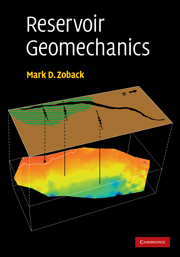12 - Effects of reservoir depletion
Published online by Cambridge University Press: 10 December 2009
Summary
Addressing problems associated with the deformation and changes of stress within and surrounding depleting reservoirs is important for many reasons. Most well known are the problems associated with casing collapse and surface subsidence that create substantial difficulties in some oil and gas reservoirs due to compaction in weak formations. The significant stress changes that occur in highly depleted reservoirs (e.g. Figure 2.10a) can make drilling a new well to deeper targets quite problematic due to the need to lower mud weights in depleted formations to avoid lost circulation. Depletion also has the potential to induce faulting, both within and outside reservoirs in some geologic environments. While these problems can be formidable in some reservoirs, depletion can also have beneficial impact on reservoir performance. For example, hydraulic fracturing can be more effective in depleted reservoirs than in the same reservoirs prior to depletion. In some weak reservoirs, compaction drive is an effective mechanism for enhancing the total amount of hydrocarbons recovered, especially if the permeability changes accompanying compaction are not severe.
To address these issues in a comprehensive manner, this chapter is organized in three sections. In the first section I consider processes accompanying depletion within reservoirs and focus initially on the stress changes associated with depletion. We begin by discussing reservoir stress paths, the reduction of horizontal stress magnitude within the reservoir resulting from the decrease in pore pressure associated with depletion.
- Type
- Chapter
- Information
- Reservoir Geomechanics , pp. 378 - 422Publisher: Cambridge University PressPrint publication year: 2007
- 1
- Cited by



